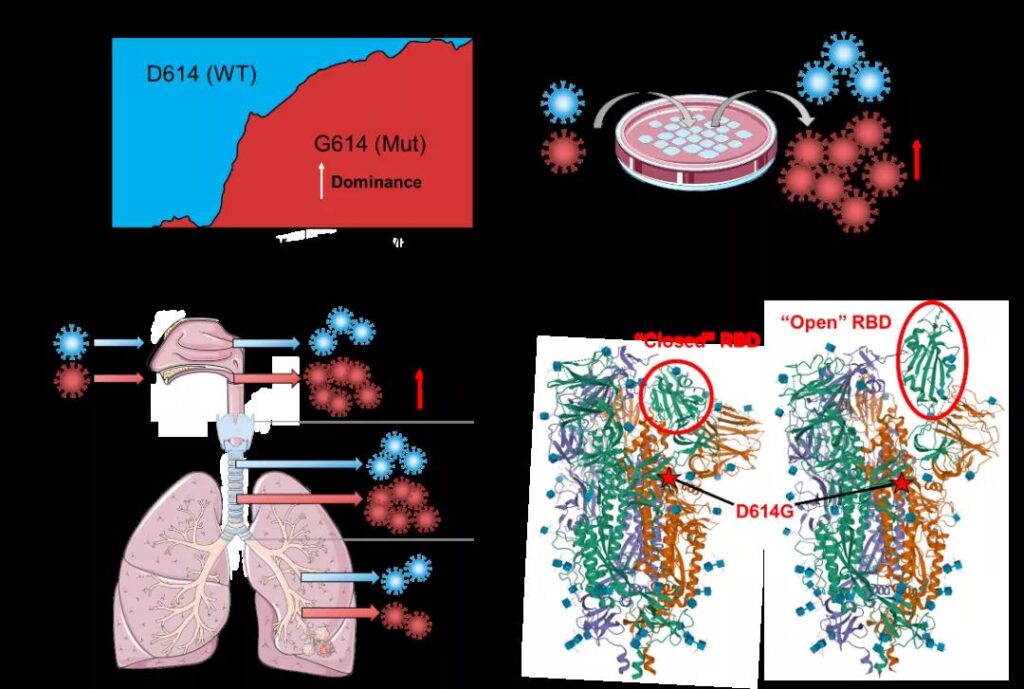Overview of the research progress of COVID-19 variant D614G
- Normal Liver Cells Found to Promote Cancer Metastasis to the Liver
- Nearly 80% Complete Remission: Breakthrough in ADC Anti-Tumor Treatment
- Vaccination Against Common Diseases May Prevent Dementia!
- New Alzheimer’s Disease (AD) Diagnosis and Staging Criteria
- Breakthrough in Alzheimer’s Disease: New Nasal Spray Halts Cognitive Decline by Targeting Toxic Protein
- Can the Tap Water at the Paris Olympics be Drunk Directly?
Overview of the research progress of COVID-19 variant D614G
Overview of the research progress of COVID-19 variant D614G. Recently, Dr. Xuping Xie from The University of Texas Medical Branch at Galveston (UTMB) and Aria C. Shi of Johns Hopkins University School of Medicine published a paper entitled Making sense in Science CHINA LIFE Sciences. A review article of spike D614G in SARS-CoV-2 transmission.
This review systematically summarizes the impact of theCOVID-19 variant D614G on virus replication, pathology, transmission capacity, vaccine and antibody effectiveness, and emphasizes the importance of paying close attention to virus mutations and functional research mutations to ensure that the COVID-19 prevention measures are still correct. The variant works.

Since the outbreak at the end of 2019, the new coronavirus (referred to as the new coronavirus or SARS-CoV-2) has ravaged the world. As of December 2020, the COVID-19 virus has infected more than 70 million people worldwide and killed more than 1.6 million people, triggering a serious human health crisis and endangering the world’s economic security.
Although most of the COVID-19 infections only produce mild symptoms, in the elderly or people with underlying diseases, the COVID-19 infection can lead to severe pneumonia and life-threatening. Based on the similarity of viral gene sequences, it is generally believed that the COVID-19 originated in bats. However, it is currently impossible to determine in which intermediate host the new coronavirus has evolved and spread to humans.
In the process of transmission, RNA viruses such as the COVID-19 will continue to mutate to adapt to different hosts. In the past year, the new coronavirus has spread widely among the population. Therefore, it is naturally not surprising that the current discovery of COVID-19 variants that are more suitable for human hosts.
This review focuses on the production of the COVID-19 variant D614G, the current status of virological research (Figure 1), and summarizes the impact of this mutation on the effectiveness of existing vaccines and antibodies.

Sequence analysis showed that in the spike protein (S for short) of all new coronaviruses in the early stage of the outbreak, the amino acid at position 614 was aspartic acid. But from March to June 2020, this amino acid quickly mutated to glycine (D614G).
At present, the D614G mutant has replaced the early virus strains and is widespread worldwide. Clinical pathological data show that although the D614G mutation is more suitable for population transmission, it does not change the pathogenicity of the virus. The emergence of D614G disease quickly attracted the attention of scientists worldwide.
Using trans-genetic systematics technology, scientists strictly compared the phenotypic differences between the mutant (G614) and the provirus (D614) in cell and animal models in the laboratory. The results showed that at the cellular level, the D614G mutation enhanced the ability of the virus to infect human cells and improved the thermal stability of the virus; in hamster and ferret animal models, the D614G mutation increased the amount of virus in the upper respiratory tract and significantly enhanced the virus. Transmission ability in animals.
Further structural biology studies have shown that the D614G mutation destroys the hydrogen bond force between amino acids D614 and T859, resulting in a conformational change of the viral spike protein, making more receptor binding regions (RBD) present an unfolded posture, thereby increasing The ability of the spike protein to bind to the ACE2 receptor. This result reasonably explains the molecular mechanism of D614G adapting to the population.
On the other hand, the rapid spread of the D614G mutant has raised concerns about the effectiveness of existing vaccines and antibodies. Scientists used different antibody titer evaluation methods to strictly compare the in vitro neutralization ability of recovered patient serum, immune vaccine serum and some monoclonal antibodies against mutants and proviruses. The results showed that the D614G mutation did not significantly affect the effectiveness of existing vaccines. However, based on the effect of D614G on the conformation of the viral spike protein, D614G may weaken the therapeutic effect of certain specific antibodies.
The last part of the review introduces new variants of COVID-19. Variants of COVID-19 with stronger transmission capabilities appeared in the United Kingdom, South Africa, Brazil and other places and became popular worldwide. Similar questions are in front of people:
1) What is the replication, spread and pathogenicity of the new variant to the virus?
2) Does the new variant affect the effectiveness of existing vaccines and antibodies?
Regarding the former, scientists are intensively researching and I believe there will be an answer soon. Regarding the latter, results have shown that some mutants partially weaken the in vitro neutralization effect of the vaccine and the serum of recovered patients, but the effect on the effectiveness of the vaccine in vivo still requires more experimental evidence.
Finally, it is necessary to identify new mutants as soon as possible, and to evaluate the effectiveness of existing epidemic prevention measures against the variants in a timely manner to ensure that existing or under development vaccines can provide sufficient protection. I believe that we can finally defeat COVID-19 and return to normal life.
Dr. Xuping Xie, assistant professor of the Medical Division of the University of Texas, is the corresponding author of the article, and Aria C. Shi of the Johns Hopkins University School of Medicine is the first author of the article.
Original link:
https://engine.scichina.com/publisher/scp/journal/SCLS/doi/10.1007/s11427-020-1893-9?slug=fulltext
(source:internet, reference only)
Disclaimer of medicaltrend.org



